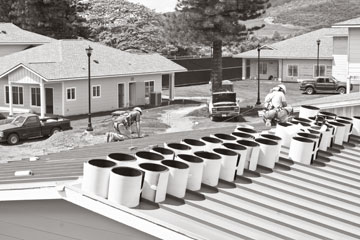
COURTESY ACTUS LEND LEASE LLC
Workers install rolls of photovoltaic film roofing at the Army Hawaii Family Housing project at Schofield Barracks. The solar roofing will provide about 30 percent of the homes' energy needs.
|
|
Army throws switch on solar energy isle housing project
Actus Lend Lease, a partner in the plan, touts conservation
If anyone ever calls the U.S. Army green, chances are it is a reference to the service's battle uniform. But a project about to be unveiled on Oahu could change that.
Actus Lend Lease LLC plans to unveil next week the first of several thousand new homes it is developing in partnership with the Army. And in an ambitious innovation, all of the housing projects will include rooftop, electricity-producing solar energy cells.
GREEN HOUSING
Project: Army Hawaii Family Housing
Where: Schofield Barracks, Wheeler, Helemano, Aliamanu, Red Hill, Tripler, Fort Shafter
Homes: 5,388 new, 2,506 renovated
Solar power: 6 megawatts, providing 30 percent of homes' electricity
Cost: $2.3 billion
Completion dates: June 1, 2006, through 2016
Developer: Actus Lend Lease LLC
|
Actus plans eventually to install enough of these panels to provide nearly a third of the electricity needed by the mammoth residential development, which Tennessee-based Actus will continue to own, operate and manage through at least 2054 under a contract with the Army.
The solar panels are not the only green aspect of the Actus project. The company reckons about 80 percent of materials from development sites will be recycled back into the construction, reducing landfill waste. And builders say they are leaving hundreds of old trees in place to preserve the natural landscape. Plus, the homes will use solar-powered water heaters.
But it is the widespread installation of solar panels known as photovoltaic cells that appears to be the most innovative step. When completed, the $2.3 billion Army Hawaii Family Housing community will include 5,388 new homes and the renovation of 2,506 existing homes in seven sites around Oahu. The housing complexes will be outfitted with enough photovoltaic cells to generate a combined six megawatts of electricity.
The project, Actus says, will be the "world's largest solar-powered community."
"We've only been able to find one other that's close to it, and that other one, in Germany, is a little bigger but it's an industrial project," said Perry Brown, technical development manager for Actus Lend Lease in Hawaii.
Most of the electricity used by the Army Hawaii Family Housing project will be generated by Hawaiian Electric Co. Inc. and delivered to homes via an Army "minigrid" at the subdivisions, Brown said.
Unlike relatively low-tech solar water heating cells, which use sunlight to heat water, photovoltaic cells use silicon film to convert sunlight into electricity, much like a solar calculator, Brown said.
Actus estimates the project will eventually save about 15,500 barrels of oil per year and reduce by about 10,000 tons annually the amount of carbon dioxide that would be released into the atmosphere by power plants producing that much power.
While all of this might suggest mammoth photovoltaic systems would be a good way to address Hawaii's energy needs, don't expect many other developers to follow Actus' lead soon. The main problem is expense, said Peter Rosegg, a spokesman for Hawaiian Electric. Photovoltaic systems are so expensive that it can take many years to recoup costs through energy savings, Rosegg said.

COURTESY ACTUS LEND LEASE LLC
Rolls of photovoltaic film roofing are installed at the new housing project at Schofield Barracks.
|
|
That could change somewhat if Gov. Linda Lingle signs a bill that would increase tax credits available to people who installed the systems. The law would allow people to get back 35 percent of a system's cost, up to $5,000. But, Rosegg said, the credit goes only part of the way toward making the systems cost-effective.
"There are a lot of things that are going to make it hard to pencil out," Rosegg said.
Plus, Rosegg said, there are many things consumers can do that provide more energy savings for the buck, such as simply installing solar water heaters.
Actus cannot say how much the mammoth solar system will cost, in part because of a confidentiality agreement with its photovoltaic system supplier, United Solar Ovonic. Brown did say, however, that Actus managed to negotiate a good deal, which was forged before Germany adopted a national energy policy that increased demand for photovoltaic cells, causing prices to surge worldwide. Regardless, he said, rising oil prices make Actus' decision look like a good one.
Ron Baird, chief executive of the Natural Energy Laboratory of Hawaii Authority on the Big Island, said Actus' move is not simply a good one, but essential to the economic future of the state and the entire nation. The cost of photovoltaic systems should not dissuade builders from putting them into homes, Baird said.
"Part of what's needed on the part of the public is to recognize we've got a problem," Baird said. "The problem is, we can get more fossil fuels, but at what price? We need to develop any sources that we can as fast as we can to lessen our dependence on oil."

